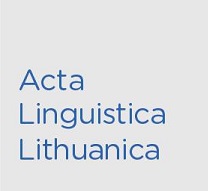
Seirijų šnektos tekstai
Review of: Asta Leskauskaitė "Seirijų šnektos tekstai"; Vilnius: Institute of the Lithuanian Language, 2016, 296 p. + 1 audio disc (CD) ISBN 978-609-411-183-9 by: Vilija Ragaišienė
More...We kindly inform you that, as long as the subject affiliation of our 300.000+ articles is in progress, you might get unsufficient or no results on your third level or second level search. In this case, please broaden your search criteria.

Review of: Asta Leskauskaitė "Seirijų šnektos tekstai"; Vilnius: Institute of the Lithuanian Language, 2016, 296 p. + 1 audio disc (CD) ISBN 978-609-411-183-9 by: Vilija Ragaišienė
More...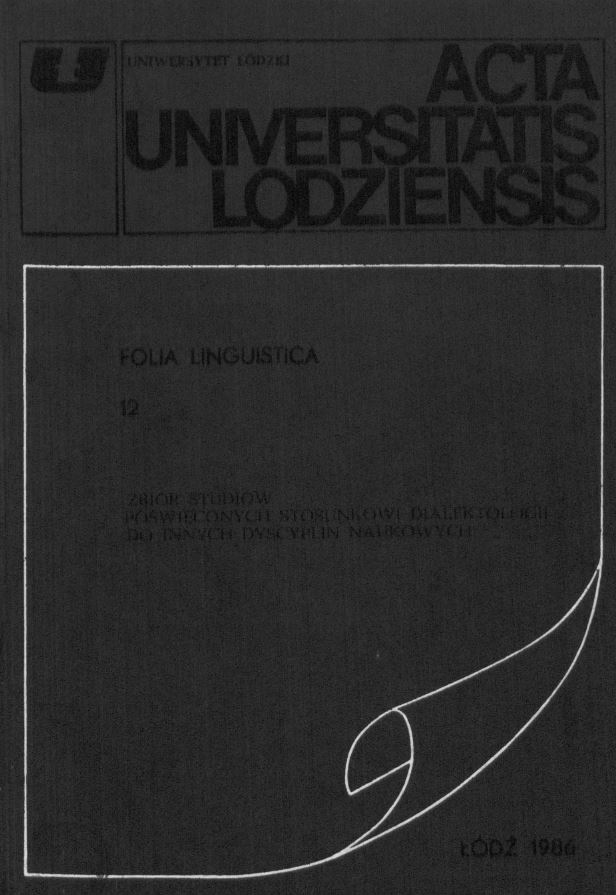
The paper presents a system analysis and computer aided research of the lexicon of a Russian dialectal packet (in Poland). The vocabulary referring to a chosen discipline (covering over 6000 words) was indexed with respect to various indispensable features like lexical geography, etymology, chronology, phonetics, word-formation, inflection, stability of the surface fore etc. The participation of words in a given cluster of synonyms, their stylistic and other features were also indexed.
More...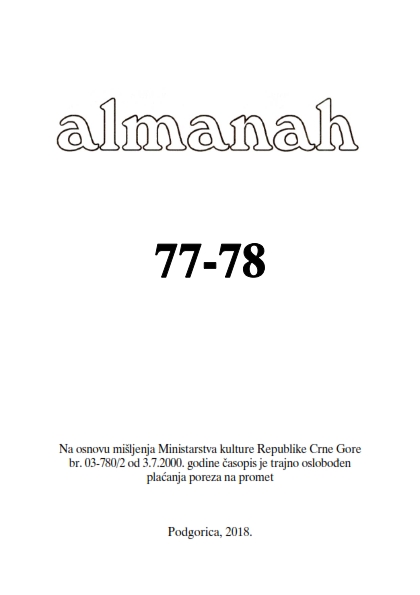
Montenegrin locutions have always caught the attention of linguists, especially of dialectologists. Those are considered to be the most detailed described locutions in Slavic world. They were studied by dialectologists from Montenegro, as well as by those from other regions, and even by some of foreign scholars. Among other things, many of them have drawn attention to some linguistic features of the population of Muslim provenance. This paper analyse how the language of Muslims (Muslims, Bosniaks, sometimes called Turks) are interpreted by Bosnia and Herzegovinian, primarily Bosniaks’, and Montenegrin linguists.
More...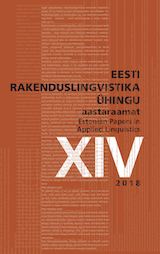
The study is an attempt to unfold the social meaning of the phenomenon of giftedness in expanded cultural context. Construal of the concept is first studied by the frequency of collocations of the synonymous signifiers of the term of giftedness in the Estonian Reference Corpus, German Reference Corpus, and British National Corpus. After that, the construction of meaning of giftedness is qualitatively studied by interviewing children and parents (15 qualitative open and non-directive mode interviews). Critical discourse analysis (Fairclough 2001) is used to show the linguistic choices and their links to discourses through which the interviewees construe the concept of giftedness, pointing to certain social relations and meanings. Results showed that giftedness was associated with childhood, highlighting the attractiveness and distinction of the phenomenon. In different languages, giftedness is associated with relatively similar features (development attractiveness, differentiation, domain-specificity) but the perceptions are different for children and parents. For children, giftedness is multidimensional but it does not get enough attention at school, whereas for parents, it is a gift from God that needs their dedication although supported by the educational system. The positive meanings of the phenomenon are made visible by children.
More...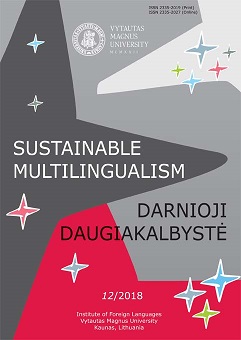
The article analyses whether the expansion of English is adding to linguistic repertoires, or whether a process of linguistic capital dispossession of national languages is taking place. It explores the role that discourses of ‘global English’ and of English as a ‘lingua franca’ play in processes of global and regional European integration. It considers whether the linguistic capital of all languages can be made productive when in much of Europe there is a marked downgrading of the learning of foreign languages other than English, alongside the continued neglect of many minority languages. Language pedagogy and language policy need to be situated within wider political, social and economic contexts. EU schemes for research collaboration and student mobility are of limited help in maintaining linguistic diversity. The Bologna process furthers European integration but intensifies the hegemony of English. Nordic universities are moving into bilingual education, combining English with a national language. The 2006 Declaration on a Nordic Language Policy aims at ensuring that Nordic languages and English develop in parallel, that all residents can maintain their languages, and that language policy issues should be widely understood. If neoliberalism and linguistic neoimperialism are determining factors, there are challenges in maintaining the vitality of languages, and organizing school and university education so as to educate critical multilingual citizens.
More...
The article presents a scientific analysis of a practical application of multilingual and multicultural education at higher education, more specifically, the description of the eTandem project developed and launched by the Language Center of the University of Padua, which won the European Language Label (ELL) in December 2016. The project was selected and nominated since it provides a methodological approach and study strategies which favour multilingualism, mobility for young people and inclusiveness. The project is based on an online exchange between Italian students enrolled at the University of Padua and international students who will be coming to the University. It differs from many other telecollaboration projects in that it involves different languages, levels of language competence as well as various ways of interaction. Indeed, it implies three different ways of communication among participants: (1) one-to-one partnership in the students’ target language; (2) many-to-many interaction in Italian and/or English/French/Spanish as linguae francae on a Moodle platform and/or in a social Facebook area; (3) one-to-many multilingual interaction carried out by e-tutors in Facebook. They provide students with useful links regarding cultural events and things to do in Padua and its surroundings, as well as recent news and interesting linguistic and cultural issues related to different countries. Mobility, informality, autonomy, reciprocity, friendship, fun and multilingual community are the key words of this initiative whose objectives are aimed at developing linguistic, cultural, personal, social and digital skills in different languages, even in the less used and less taught ones.
More...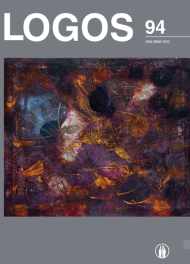
An increasing amount of vulgarity is becoming more and more obvious in public social life as well as in individual behaviour. Vulgarity of speech is gradually becoming acceptable even in public discourse. The article aims at understanding the possible reasons of this socio-cultural trend, as well as establishing the terms of its theoretical analysis. The aim of this pilot research project is to introduce and define the Lithuanian term of “vulgarity journalism” in the attempt to explain its growing popularity, and to review the characteristic examples of linguistic vulgarity in public discourse. The reasons for vulgarisation of public discourse relate to the concept of the 20th century aesthetics of ugliness in culture. Review of examples from the Lithuanian context allows one to make a conclusion. The principal reasons for vulgarity in public discourse are aspirations to communicate criticism to the lowest social layers in a sarcastic manner. Language decorum is seen as an imposition and as an impediment to the freedom of expression/ thought of an individual who considers himself superior to his society.
More...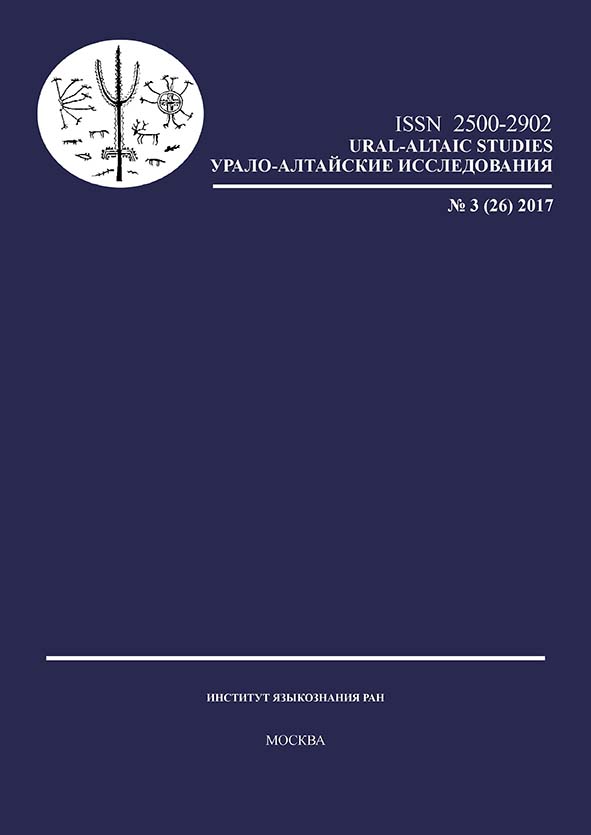
This paper discusses sentences involving passivization of matrix predicates that take finite CPs with accusative subjects in Buryat. It examines several potential derivations of such sentences, including long-distance passivization, raising and control structures. I argue that long-distance movement in Buryat is limited to restructuring verbs that do not take ECMclauses. Therefore, the long-distance passivization analysis is excluded for the predicates under consideration. Two other potential derivations — the raising structure and the control structure are both attested in Buryat and can be distinguished by different agreement patterns on embedded verbs.
More...
Studying a translated missionary monument ― a confession written in the folk-spoken language of Sergach Mishars in the later half of the 19th century ― is of great interest for comparison with modern spoken and literary Tatar language. This test, being a linguistic monument of the dialect of the Sergach Mishars, contains extensive material on the spoken language, which has sound correspondences with contemporary dialects of the Tatar language; ancient dialectic relations can be traced through it, as well. The article aims to obtain new information about the Mishar dialect system of that period using the translated text. Our research allows to introduce factual areagraphic material into scientific use, and thus promotes a more complete study of the centuries-old history and culture of the nation in their local performances.
More...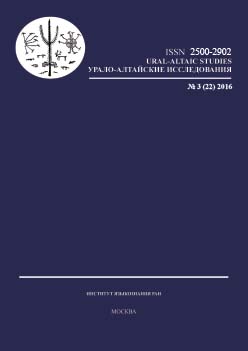
The paper presents the recent situation of Bulgarian Muslim Roma, speakers of Turkish, migrants in Germany. After their arrival to Germany most of the Bulgarian Muslim Roma contact the Turkish community, because they speak a variety of Turkish and it serves as a tool of communication. Being in a new environment, Bulgarian Muslim Roma learn a new for them variety of Turkish spoken in Berlin, considering it a High variety in terms of diglossia; that way, a new form of diglossia between two dialects is created. The paper describes changes in Turkish language spoken by Roma as well as forms of code-switching between Turkish and Bulgarian. At the same time, a new phenomenon among Bulgarian Muslim Roma is observed — a process of assimilation towards the Turkish community. All linguistic and social phenomena among the Muslim Roma community can be explained by means of existing theories in the field of sociolinguistics.
More...
During time period 2009-2016 two interdisciplinary research projects were carried out with focus on the sociolinguistic situation of the Slovakian youth living in the Lowlands. Both projects were interconnected on the base of thematic orientation and methodology and focused on the language-communication behavior of the Slovakian youth in situational context of intra-ethnic use of spoken Slovak in Hungary, Croatia, Serbia, and Romania. Basic conditions for respondent’s inclusion into research samples were: Slovakian origin (nationality and mother tongue of parents); spoken Slovak command on the level of workaday, ordinary communication; quota selection according to gender, age, and education (younger group N=70 15-19 of age, secondary school students mostly and older group, N=37 20-25 of age, university students mostly). Participants were selected in the secondary schools and universities with Slovakian language lecturers, eventually culturally oriented organizations, unions and clubs, in which youth associates and uses Slovakian language as communication tool. The main instrument used for data collection were structured questionnaire which consisted of questions oriented on the language/communication behaviour in the formal (public) and informal (family) settings. In this article we concentrate on the results connected with Slovakian youth living in Romania, namely in two regions: Bihor and Nadlak. Our aim is to introduce this language group on the level of basic sociolinguistic and ethno-cultural characteristics, namely 9 indicators: language behaviour; situational Slovak language usage (in school and out of school); communicational knowledge of language variety; impact of communicational knowledge of Slovak language on relationships strengthening; language code switching; language improvement; personal value of mother tongue; attitudes to the functions of mother tongue; ethno-cultural development indicator. Obtained data were analysed in SPSS 21 statistical package. Results connected with language behaviour in the formal and informal environment confirmed majority of tendency to communicate in Slovak language, especially in the family settings. Preference of mother tongue as personal value is very high. Slovak language usage is frequent in communication inside but also outside the school. Significant connection between age and communication outside school settings were confirmed - the younger group more frequently uses Slovak language in ordinary communication. According to the expressions of respondents, communicational knowledge of all monitored language forms (three Slovakian varieties and Romanian language) is high. Significant connections between Slovak language command and family relationships and also peer relationships were confirmed, and these ties in the case of family settings were stronger for women. Language code switching, transition from one language to another is dominantly determined by language competencies of both sides (communicators and recipients) and less by thematic aspect of conversation. More frequent described switch was from Slovak to Romanian as reverse. Respondent’s opinion about existing possibilities for Slovak language improvement is overwhelmingly positive and most of them expressed necessity of such kind of activity. Young people’s preference of mother tongue as personal value is high, and also their attitudes to the functions of mother tongue. Ethno-cultural indicator also reflected respondent’s predominantly positive attitudes to the national cultural development, mother tongue knowledge improvement, and minority school system development.
More...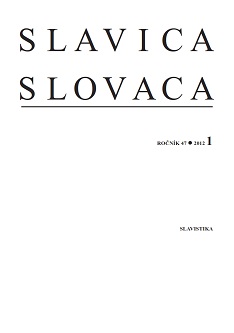
The article introduces the history of the research into the biggest Slovenian sub-dialect group, i.e. the Dolenjska sub-dialects. The subject kept arousing interest from the 16th century mainly in the Slovenian as well as the wider European territory. The article brings a commented overview of the research into Slovenian dialects paying special attention to the research into the Dolenjska and East-Dolenjska sub-dialects and dialectological phenomena related to the sub-dialects in question.
More...
This paper is devoted to the study of linguistic associations. Revealing ethnic, cultural, historical and spiritual values of a nation, they become an important source of knowledge. Results of the association tests using linguistic data collected from the Russian media of the last twenty years show that this method is capable of constructing a hierarchy of the Russian cultural values.
More...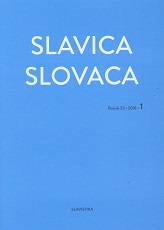
ŽEŇUCH, P. – ZUBKO, P. et alii: Liturgické jazyky v duchovnej kultúre Slovanov. Monotematický súbor štúdií. Bratislava: Slavistický ústav Jána Stanislava SAV a Slovenský komitét slavistov, 2017. 368 s. GÁBOR, Ľ: Ľudová próza západných Slovanov v komparatistickej perspektíve. Sondy do literárnej predhistórie. Banská Bystrica: Belianum, vydavateľstvo Univerzity Mateja Bela, 2017. 154 s. Nová učebnica staroslovienčiny a rusínskej diachrónnej jazykovedy MRŇÁVEK, Т.: Vývoj a struktura liturgie sv. Jana Zlatoústého. Praha: Nakladatelství Pavel Mervart, 2017. 232 s. SEVŠEK ŠRAMEL, Š. – PALLAY, J. (eds.): Sedemdeset let slovakistike v Ljubljani: posvečeno Andreju Rozmanu. Ljubljana: Znanstvena založba Filozofske fakultete, 2017. (Knjižna zbirka Slavica Slovenica; št. 2). 278 s. KILIÁNOVÁ, G. – ZAJONC, J. (eds.): 70 rokov Ústavu etnológie Slovenskej akadémie vied: kontinuity a diskontinuity bádania a jednej inštitúcie. Bratislava: VEDA, 2016. 288 s. KILIÁNOVÁ, G. – POTANČOK, V. (eds.): PhDr. BOŽENA FILOVÁ, CSc., členka korešpondentka SAV: osobnosť, dielo a personálna bibliografia. Bratislava: Ústav etnológie SAV, 2017. 87 s.
More...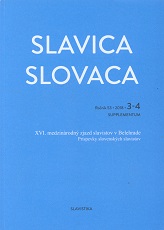
Over the past more than two decades one can observe abrupt changes in the development tendencies of all Slavic languages. These changes are manifested mainly in the language internationalization, in the wiping differences between language styles, but also in the ignorance of valid language norms. The following article presents the (im)possibility of lexicographic processing of current language situation that is observable in lexical and word-formative dynamics through an example of the Bulgarian-Slovak dictionary.
More...
The extensive phraseology collection reflecting the linguistic image of the handicraft in Slovak and Polish can be classified into two blocks: 1. the general perception of the craft, 2. the perception of the specific crafts. Both blocks are interconnected by basic semantic categories (by the person carrying out the craft, the craft activity, the object of craft activity), as well as the most significant social and existential aspect, weaker captured gender, ethical, psychological, local and time-related aspects with their own signs. These features point to the common perception of craft arising from linguistic and cultural proximity, but their more detailed semantic specifications often reveal two unique interpretations based on complementarity, not contrast. The similarities in Polish and Slovak folk image of the craft are revealed through formally and semantically identical phraseological units, the number of which is. More often we can find the grips with semantically similar units that are partly different from a lexical, syntactic or morphological point of view. Semantically close, but formally dissimilar units are the most representative in Slovak-Polish image of the craft, and therefore represent the material and content basis of the analyzes contianed in the contribution.
More...
The paper aims to capture the current state of Vojvodina Slovak as an enclave language in Serbia in regards to the latest dynamic processes at the level of its phonetic, grammatical, lexical and pragmalinguistic functions. The study examines the development tendencies of the Vojvodina Slovak language against the background of the strong pressure of Serbian. It appears that the written form of Vojvodina Slovak used in public communication, especially in print, electronic media and publishing, is strongly influenced by Standard Slovak codified in Slovakia. At the same time, it retains its own „Vojvodina attributes“ resulting from the underlying dialect and bilingual context.
More...
The part of elementary postulates of cognitive linguistics is the premise that metaphor is not only linguistic but also primary mental and culturally determined phenomenon that allows us to think and communicate about abstract entities as sensually perceived things or phenomena. Human being, his interpretation of the world is largely contingent on the correlation of physical and subjective experiences. This causes the same metaphors in genetically and typologically different languages. On the other hand, we register conceptual metaphors reflecting intercultural differences that are conditional on specific religious and cultural ideas, historical-ideological development of the given community and its cultural tradition. The aim of the work is cognitive analysis of conceptual metaphors of selected emotional concepts in Slovak language. The research of concept „profiling“ also implies broader cultural aspect.
More...
This paper focuses on the relations between language, culture and identity in the environment of ethnic minorities on the example of Lowland Slovaks – Slovak communities existing in Hungary, Serbia, Romania and Croatia. The diversity of their language, culture and identity, which can be seen today, is the result of their (somewhere more than historical) coexistence with national majority and other minorities. This situation and perspectives are not just results of the past (especially post-Ottoman and national-emancipation periods), but mainly results of the multinational Europe from the second half of the 20th century and increasingly more of the euro-unionization and globalization.
More...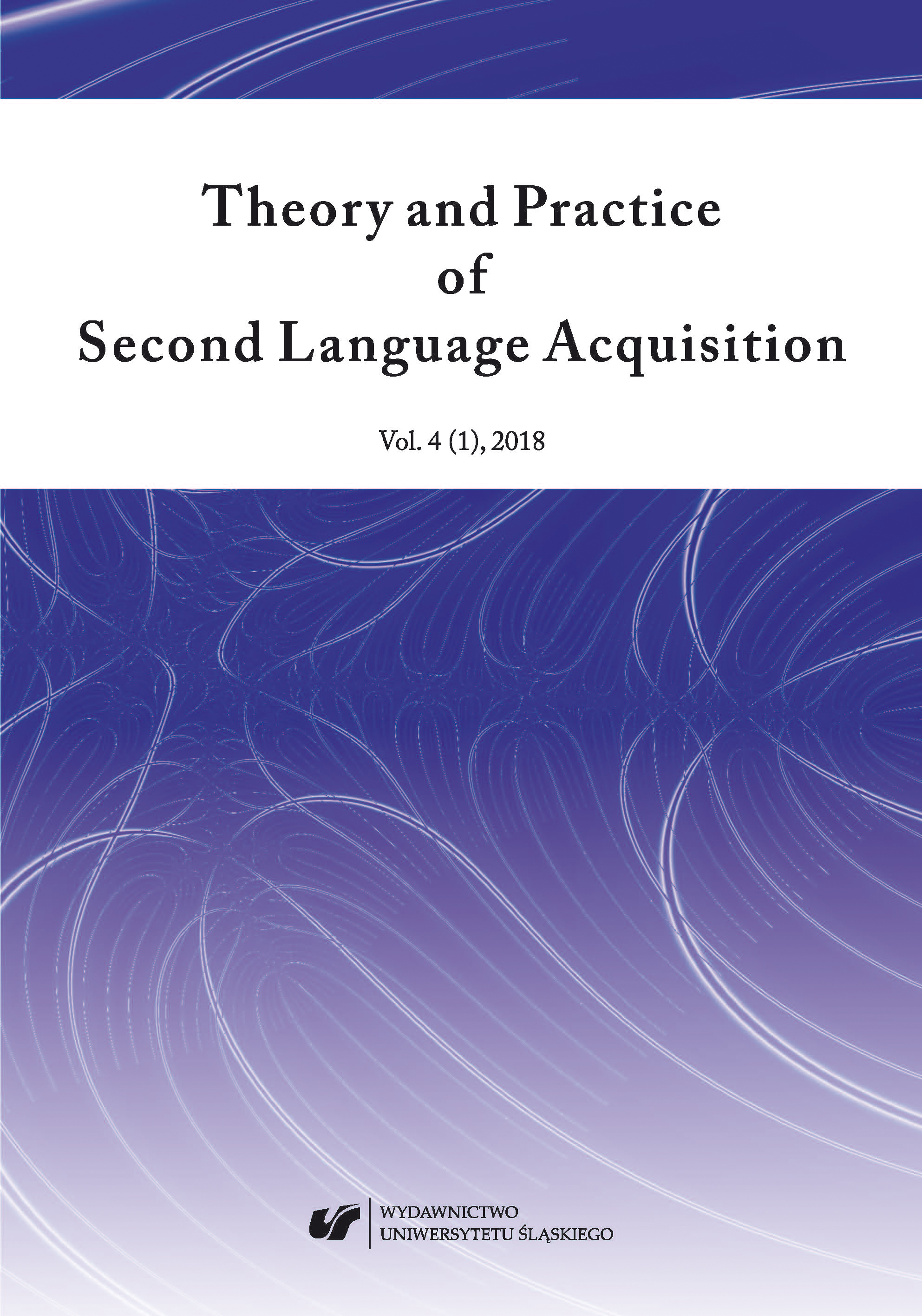
The “love factor” has increasingly figured in SLA research. Thus, Piller (2002) studied the language “glue” between cross-lingual couples; Marinova-Todd (2003) found a link between L2 proficiency and co-habitation with native speakers; Muñoz and Singleton (2007) reported a romantic connection between successful late L2 learners and native speakers; Gonçalves (2013) explored hybridity in bicultural relationships; and Kinsella and Singleton (2014) found that the participants in their study of late L2 learners whose L2 test results were all within native-speaker range had native-speaker life-partners. This issue is now being taken very seriously, as Dewaele and Salomidou’s (2017) recent article on “loving […] in a foreign language” demonstrates. In the present article we report on the results of some recent qualitative research, based on interview data collected from five individuals who are involved in intercultural and cross-lingual relationships. The research shows the L2 learning process to be clearly influenced by the affective context in which it occurs. The data also suggest that identity construction may be moved in a particular direction by the language principally adopted by the couple, and that, for the partner for whom this language is an L2, the results can be dramatic in terms of both linguistic and cultural affiliation.
More...